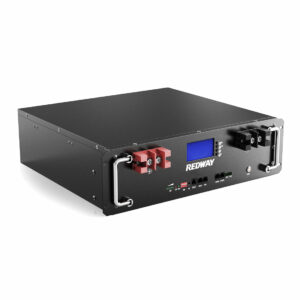What is the purpose of a server rack?
Server racks are standardized enclosures designed to securely house and organize IT equipment like servers, switches, and UPS systems. They optimize space, improve airflow for cooling, and enable centralized management. Built to 19-inch width standards, they support modular scalability while protecting hardware from physical damage or unauthorized access. 48V Rack Battery
What problem does a server rack solve?
Server racks address space inefficiency, thermal mismanagement, and cable disorganization in IT environments. By vertically stacking equipment in standardized units, they prevent overheating and simplify maintenance while reducing footprint.

Without racks, servers placed haphazardly on shelves or floors consume 3-4x more space and suffer 25-40% higher failure rates due to poor airflow. Pro Tip: Always leave 20% vertical space for future expansion and airflow optimization. For example, a 42U rack can hold 42 units (1U=1.75″ height) like blade servers, patch panels, and cooling fans. Transitional shelves help organize cables, while locking doors deter tampering. But how do you balance density with accessibility? Modular rails and sliding mounts let technicians service hardware without disassembling adjacent systems.
Why are server rack dimensions standardized?
Standard 19-inch widths and rack unit (RU) heights ensure cross-vendor compatibility. This uniformity lets admins mix servers, switches, and power strips without custom brackets.
The Electronic Industries Alliance (EIA-310-D) mandates 19″ (482.6mm) width between mounting rails, with 1U=1.75″ vertical spacing. Depth varies (600-1200mm) to accommodate different gear. Pro Tip: For mixed-depth setups, use adjustable rails or cantilever shelves. Ever seen a pizza-box server? Its 1U design fits snugly, while deeper units like UPS systems may need 36″+ racks. Transitional brackets adapt legacy gear, but sticking to standards future-proofs your infrastructure. A real-world example: Netflix uses Open Compute racks with 21″ widths for hyperscale efficiency, but these require proprietary hardware.
| Feature | Traditional 19″ Rack | Open Compute Rack |
|---|---|---|
| Width | 19″ | 21″ |
| Vendor Lock-in | Low | High |
| Max Density | 42U | 48OU |
How do server racks improve cooling?
Racks enable hot/cold aisle containment and direct airflow through perforated doors, side vents, and vertical exhaust ducts. This reduces bypass airflow by up to 60% compared to open setups.
Modern racks feature adjustable blanking panels to seal unused U-spaces, forcing cool air through equipment instead of around it. Pro Tip: Pair with containment curtains and variable-speed fans for dynamic cooling. Imagine a wind tunnel—air enters front grilles at 18-27°C, absorbs heat from components, and exits rear ducts at 35-40°C. Transitional liquid-cooled doors (like those from Vertiv) can handle 20kW/rack loads. But what if you’re budget-constrained? Start with brush strips to block cable openings—they cut leakage by 30%.
| Cooling Method | Airflow Efficiency | Cost per Rack |
|---|---|---|
| Passive Vents | 40-50% | $200 |
| Active Fans | 70-80% | $1,500 |
| Liquid Cooling | 90-95% | $8,000+ |
What security features do server racks offer?
Racks provide physical access controls like lockable doors, biometric scanners, and tamper-proof side panels. Mesh doors allow airflow while blocking casual tampering; solid doors add privacy for sensitive hardware.
High-security racks meet SOC2 or HIPAA requirements with features like intrusion sensors, CCTV mounts, and seismic bracing. Pro Tip: Use round-key locks instead of tubular—they’re harder to pick. For example, financial institutions often use racks with IGLOO-T10 locks and 12-gauge steel walls. Transitional cages within data centers add another layer, but remember: a $300 lock won’t protect against a $10 wrench. Always anchor racks to floors/walls to prevent tipping during disasters.
How do racks optimize space utilization?
Vertical stacking in racks saves up to 75% floor space versus horizontal layouts. Adjustable rails and sliding mounts allow dense packing without sacrificing serviceability.
High-density racks like APC’s NetShelter CX hold 50+ servers in 42U, whereas traditional setups might only fit 15-20. Pro Tip: Use zero-U PDUs and overhead cable trays to free U-space. Think of it like a skyscraper vs. suburban sprawl—racks build upward, not outward. Transitional cable arms let you slide out servers without disconnecting wires. But how deep is too deep? Deeper racks (42″) suit blade enclosures, while 24″ models fit basic switches.
Why are server racks critical for scalability?
Racks support modular expansion through standardized mounting points. Admins can add servers, storage, or UPS units incrementally without redesigning infrastructure.
For every 10 racks added, modular designs reduce deployment time by 35% compared to standalone setups. Pro Tip: Reserve top/bottom U-spaces for PDUs and cable managers. Imagine building with LEGO—each component snaps into place predictably. Transitional cloud providers like AWS use rack-scale designs where entire racks ship as pre-configured units. But what if you mix old and new gear? Stick to EIA-310 compliance, and avoid proprietary rail kits.
RackBattery Expert Insight
FAQs
Can any server fit in a standard rack?
Most 19″ compliant servers do, but check depth and weight—rack depths range from 24″ to 48″, and heavier units need reinforced rails.
How often should racks be inspected?
Bi-annually for load balance, bolt tightness, and cleanliness. Dust buildup can reduce cooling efficiency by 15% annually.
Are open-frame racks secure enough?
Only for low-risk environments. Use enclosed racks with locks in shared spaces—90% of physical breaches target unsecured equipment.



